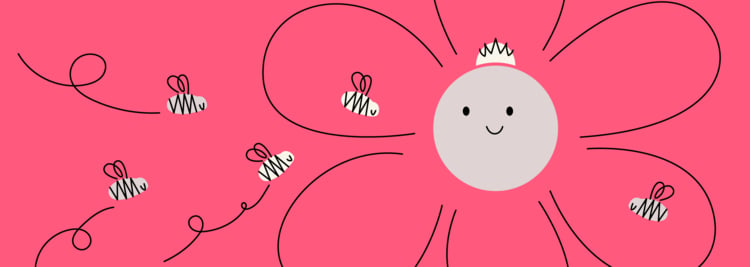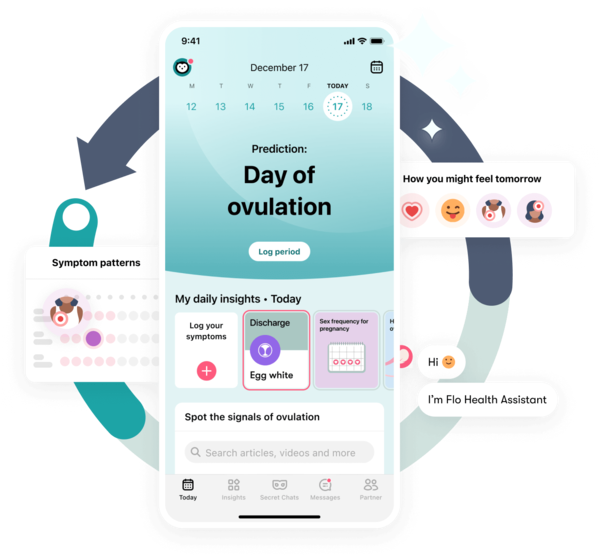When you’re trying to conceive, the number one question on your mind may be, "When is a woman most fertile?" Though the answer depends on many different factors, there are certain steps you can take to pinpoint peak fertility and increase your chances of successful conception.
-
Tracking cycle
-
Getting pregnant
-
Pregnancy
-
Help Center
-
Flo for Partners
-
Anonymous Mode
-
Flo app reviews
-
Flo Premium New
-
Secret Chats New
-
Symptom Checker New
-
Your cycle
-
Health 360°
-
Getting pregnant
-
Pregnancy
-
Being a mom
-
LGBTQ+
-
Quizzes
-
Ovulation calculator
-
hCG calculator
-
Pregnancy test calculator
-
Menstrual cycle calculator
-
Period calculator
-
Implantation calculator
-
Pregnancy weeks to months calculator
-
Pregnancy due date calculator
-
IVF and FET due date calculator
-
Due date calculator by ultrasound
-
Medical Affairs
-
Science & Research
-
Pass It On Project New
-
Privacy Portal
-
Press Center
-
Flo Accuracy
-
Careers
-
Contact Us
When Is a Woman Most Fertile? A Cheat Sheet to Getting Pregnant


Every piece of content at Flo Health adheres to the highest editorial standards for language, style, and medical accuracy. To learn what we do to deliver the best health and lifestyle insights to you, check out our content review principles.
How many fertile days are in a cycle?
It’s only possible to get pregnant in the first 24 hours after ovulation, but your fertile window — the ideal time to have sex — is much longer.
You’re actually capable of ovulating once from each ovary (and at least 24 hours apart), so your ovulation window lasts roughly 72 hours. It should be noted that ovulating from both ovaries isn’t especially common.
After intercourse, sperm can live in the body for up to five days. This means that having sex as early as four days before ovulation could still result in a pregnancy.
Furthermore, any day you spot cervical fluid is potentially a fertile day. The bottom line? Although conception can only occur on a maximum of three days per cycle, your fertile window, when sex may result in pregnancy, may last up to eight days.
When does ovulation take place?

Take a quiz
Find out what you can do with our Health Assistant
It’s a common misconception that ovulation always occurs on the 14th day of your cycle. This myth is based on the assumption that it lands smack dab in the middle of an average 28-day cycle.
In reality, the average menstrual cycle ranges anywhere from 21 to 35 days in length, and ovulation is much trickier to predict. It generally happens between days 11 and 21 in a cycle.
It’s a common misconception that ovulation always occurs on the 14th day of your cycle. In reality, the average menstrual cycle ranges anywhere from 21 to 35 days in length, and ovulation is much trickier to predict.
Remember, ovulation could technically occur at any point, including during your period. Therefore, the best way to definitively determine when ovulation occurs is by tracking your basal body temperature.
When is the prime time for conception?
An egg is viable for up to 24 hours once released, so the window for conception is pretty small. The prime time to have sex is on the day of, or the day after, ovulation. However, the presence of wet or slippery cervical fluid is a strong indication of fertility, and sex on the days prior to ovulation can result in pregnancy. Engaging in intercourse prior to ovulation ensures the sperm will be there waiting to fertilize the egg upon its release.
How do you know when you’re fertile?

Here are four popular methods for detecting ovulation and peak fertility.
1. Ovulation calculators
Ovulation calculators work by taking the date of your last period and your average cycle length to provide an estimated date of ovulation. Though they aren’t the most accurate method, they’re still a viable option for people with very regular menstrual cycles.
2. Home ovulation tests
Similar to home pregnancy tests, home ovulation tests detect the presence of a specific hormone in your urine. Pregnancy tests detect human chorionic gonadotropin (hCG), and ovulation tests detect luteinizing hormone (LH). A surge in LH triggers your ovary to release an egg.
These kits come in handy for people having difficulty monitoring fertility signs or who just want confirmation. The main drawback of these tests is that if the test fails to pick up the LH surge before ovulation occurs, then your fertile window has already closed.
3. Basal body temperature
Did you know that your body temperature actually increases after ovulation? This shift is subtle and rarely noticeable without the aid of a thermometer and careful monitoring of your basal body temperature (BBT). Your BBT is the temperature of your body immediately upon waking up in the morning, before you move around or speak.
To chart basal body temperature, you’ll need to check it every day within the same half-hour time period. When you detect an increase of at least three-tenths of a degree (compared to the last 6 days), you’re probably ovulating.
Your BBT is the temperature of your body immediately upon waking up in the morning, before you move around or speak.To chart basal body temperature, you’ll need to check it every day within the same half-hour time period.
Unfortunately, other factors affecting body temperature, such as illness, can interfere with the process, so it can take a few cycles to determine how your BBT correlates to ovulation.
Much like at-home tests, the downside here is ovulation cannot be fully confirmed until after the fertile window has closed.
4. Cervical mucus
The cervical mucus method is one of the most effective and natural ways to determine whether you’re fertile. It also has the added bonus of predicting ovulation before it happens.
Cervical fluid is the clear to whitish discharge you get throughout your cycle. Sometimes it’s sticky or lotiony. If you’re about to begin ovulating, it’s wet and slippery like egg whites. Note that sperm have the best chances for survival in cervical fluid that is wet and slippery.
Cervical fluid is the clear to whitish discharge you get throughout your cycle. Sometimes it’s sticky or lotiony. If you’re about to begin ovulating, it’s wet and slippery like egg whites.
Tracking your cervical fluid is as simple as observing its consistency whenever you go to the bathroom. Most women notice a gradual increase from none (on dry days) to sticky, then lotiony, then watery, and then egg-whitish.
The easiest way to check is at your vaginal opening. Alternatively, you can check your cervix by washing your hands and inserting one finger as far as possible into your vagina, near your cervix. Remove the finger and inspect the mucus. If it’s in the egg white phase, you’ll be able to stretch it between two fingers.
Is there any correlation between age and fertility?
Technically, any woman who is ovulating and sexually active is capable of becoming pregnant. But when it comes to age, the answer to "when is a woman most fertile?" is when she’s younger.
As your ovaries and eggs age, it becomes harder to successfully conceive and carry a pregnancy to term. Hormonal fluctuations in perimenopause create irregular cycles that are sometimes anovulatory (without ovulation). This makes it more difficult to conceive.
Hormonal fluctuations in perimenopause create irregular cycles that are sometimes anovulatory (without ovulation). This makes it more difficult to conceive.
However, it’s still possible to get pregnant after the age of 35. Make an appointment with your doctor to test your hormone levels and zero in on any possible barriers to conception after six months of trying without success.
By identifying your fertile window and learning how and when ovulation occurs, you’ll finally know the answer to the question, “When is a woman most fertile?"


Hey, I'm Anique
I started using Flo app to track my period and ovulation because we wanted to have a baby.


The Flo app helped me learn about my body and spot ovulation signs during our conception journey.


I vividly
remember the day
that we switched
Flo into
Pregnancy Mode — it was
such a special
moment.
Real stories, real results
Learn how the Flo app became an amazing cheerleader for us on our conception journey.
References
History of updates
Current version (14 April 2020)
Published (27 September 2019)
In this article

Get your personal guide to fertility
-
Learn how to read your body's ovulation signals
-
Find daily conception tips from our experts
-
Chat with others who are trying to get pregnant




